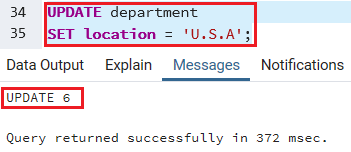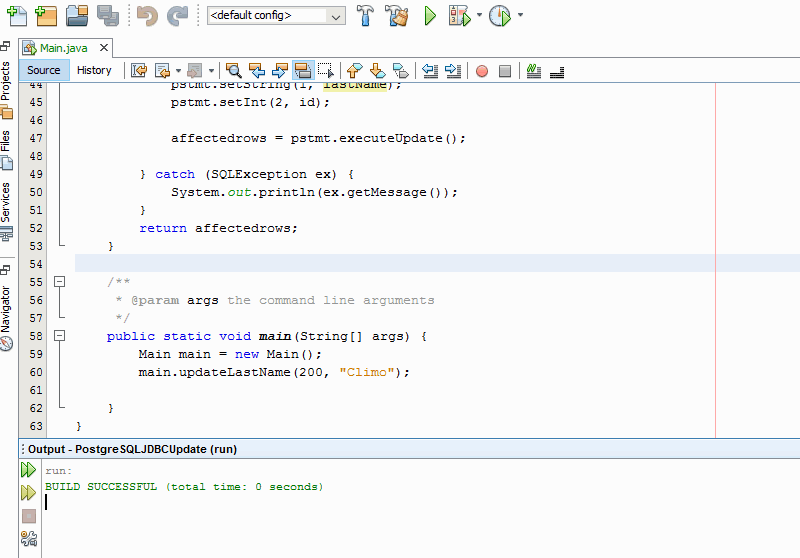

Read: PostgreSQL add primary key Postgresql update join example Let’s check the output for the above query. UPDATE "table" t1 SET "column"=0 WHERE t1.column2=1234 We enable a column name with a long table name, we can use a table alias to save some typing and make our query more readable. If we use table aliases for the long table name to make more readable queries. It means that we discard the AS keyword like this. Same to column aliases, the AS keyword is optional. In this syntax, the table_name is given an alias as alias_name. Table aliases briefly assign tables new names through the execution of a query. We should not include the table’s name in the specification of a target column like UPDATE table_name SET table_l = 1 is false. The column name is qualified with a subfield name or array subscript if needed. The name of a column within the table is named such as table 1. Suppose, table it’s getting parsed as a table named t1. Read: Postgresql Having Clause Postgresql update join with aliasĪlias in PostgreSQL is a temporary name given to a table. Postgresql update join slow after updation

UPDATE weather SET temp_lo = temp_lo+1, temp_hi = temp_lo+15, prcp = DEFAULT We have a table named weather and here is the update query for it. If we are trying to update the table1 with the corresponding row from table2, we want to use the WHERE clause. The UPDATE statement does not support GROUP BY in Postgresql.

The below statement describes the syntax of the GROUP BY clause. Secondly, list the columns that we want to group in the GROUP BY clause. Firstly, we will choose those columns that we want to group e.g., column1 and column2, and column that we want to apply an aggregate function (column3). We can use an aggregate function to calculate the sum of items in each group, such as SUM(), or COUNT() to determine the number of things in each group. The GROUP BY clause in Postgresql will divide the rows returned from the SELECT statement into groups. Read: Postgresql while loop Postgresql update join group by Postgresql update left join after updating WHERE Movie_Genres.movie_id = g.movie_id RIGHT JOIN Movies AS m on g.genre_id = m.genre_id Let’s check the syntax for self-join and we will use RIGHT join for implementation. We have two tables Movies and Movies_genre. Basically, we have to update the self-join statement.
#Postgresql update full#
Self-join is implemented through INNER, LEFT, RIGHT, FULL joins. The only difference is that this time the Table2 table will also be the same as Table1. The syntax for self-join is the same as normal joins. We have to set the comparison and eliminate the condition of the same rows. The self-join is checked as a joining of two copies of the same table. For performing a self-join, we have to reference the same table two times but with various aliases to discard confusion between tables. Self-join in PostgreSQL is generally a query to merge the same tables with different aliases. Read: PostgreSQL Loop Examples Postgresql update self join LEFT JOIN subquery on m.genre_id = subquery.genre_id We have taken the examples of the tables which we created earlier i.e. Postgresql update joins subquery basically means to update the join statement. If we use a JOIN in an UPDATE statement, we can perform a cross-table update which means that a record in a table will be changed if a value matched records from the second table. The JOIN operator in Postgresql is used to match and combine records from different tables. If we discard the WHERE clause from our UPDATE statement, the values for the column will be changed for every row in the table. WHERE clause is used in which we can describe the conditions that dictate which rows get updated. The UPDATE statement in Postgresql is used to change the value of a column in a table. We have a detailed discussion on the topic “ Postgres update with join“. For each row of table1, the UPDATE statement will check every row of table2. The FROM clause must appear right after the SET clause. To join another table in the UPDATE statement, we will describe the joined table in the FROM clause and provide the join condition in the WHERE clause. If an UPDATE statement is used in JOIN then we are able to show a cross-table update which means that a record in a table is changed if a value matched records from the other table. The JOIN in Postgresql is basically used to match and combine records from various tables. If we modify the WHERE clause from our UPDATE statement, the values for the column get changed for each row in the table. We will explain the conditions that tell which rows get updated by using a WHERE clause. In Postgresql, the UPDATE statement is usually used to change the value of a column in a table.

Postgresql update join same table Postgresql update join


 0 kommentar(er)
0 kommentar(er)
